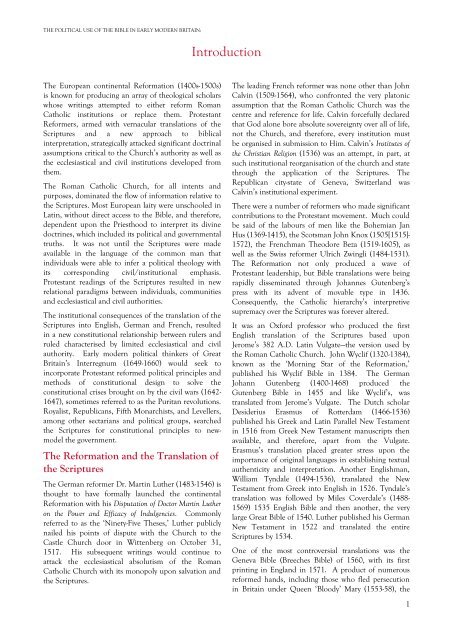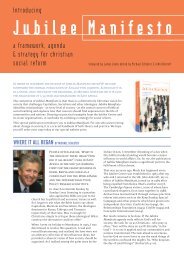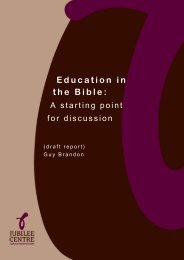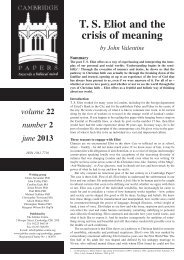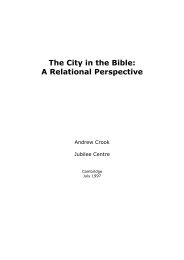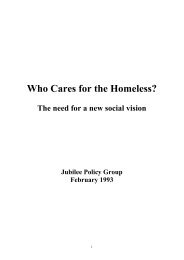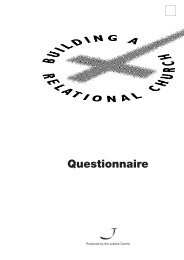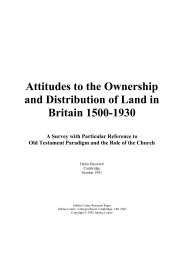Report Template - Jubilee Centre
Report Template - Jubilee Centre
Report Template - Jubilee Centre
You also want an ePaper? Increase the reach of your titles
YUMPU automatically turns print PDFs into web optimized ePapers that Google loves.
THE POLITICAL USE OF THE BIBLE IN EARLY MODERN BRITAIN:<br />
Introduction<br />
The European continental Reformation (1400s-1500s)<br />
is known for producing an array of theological scholars<br />
whose writings attempted to either reform Roman<br />
Catholic institutions or replace them. Protestant<br />
Reformers, armed with vernacular translations of the<br />
Scriptures and a new approach to biblical<br />
interpretation, strategically attacked significant doctrinal<br />
assumptions critical to the Church’s authority as well as<br />
the ecclesiastical and civil institutions developed from<br />
them.<br />
The Roman Catholic Church, for all intents and<br />
purposes, dominated the flow of information relative to<br />
the Scriptures. Most European laity were unschooled in<br />
Latin, without direct access to the Bible, and therefore,<br />
dependent upon the Priesthood to interpret its divine<br />
doctrines, which included its political and governmental<br />
truths. It was not until the Scriptures were made<br />
available in the language of the common man that<br />
individuals were able to infer a political theology with<br />
its corresponding civil/institutional emphasis.<br />
Protestant readings of the Scriptures resulted in new<br />
relational paradigms between individuals, communities<br />
and ecclesiastical and civil authorities.<br />
The institutional consequences of the translation of the<br />
Scriptures into English, German and French, resulted<br />
in a new constitutional relationship between rulers and<br />
ruled characterised by limited ecclesiastical and civil<br />
authority. Early modern political thinkers of Great<br />
Britain’s Interregnum (1649-1660) would seek to<br />
incorporate Protestant reformed political principles and<br />
methods of constitutional design to solve the<br />
constitutional crises brought on by the civil wars (1642-<br />
1647), sometimes referred to as the Puritan revolutions.<br />
Royalist, Republicans, Fifth Monarchists, and Levellers,<br />
among other sectarians and political groups, searched<br />
the Scriptures for constitutional principles to newmodel<br />
the government.<br />
The Reformation and the Translation of<br />
the Scriptures<br />
The German reformer Dr. Martin Luther (1483-1546) is<br />
thought to have formally launched the continental<br />
Reformation with his Disputation of Doctor Martin Luther<br />
on the Power and Efficacy of Indulgencies. Commonly<br />
referred to as the ‘Ninety-Five Theses,’ Luther publicly<br />
nailed his points of dispute with the Church to the<br />
Castle Church door in Wittenberg on October 31,<br />
1517. His subsequent writings would continue to<br />
attack the ecclesiastical absolutism of the Roman<br />
Catholic Church with its monopoly upon salvation and<br />
the Scriptures.<br />
The leading French reformer was none other than John<br />
Calvin (1509-1564), who confronted the very platonic<br />
assumption that the Roman Catholic Church was the<br />
centre and reference for life. Calvin forcefully declared<br />
that God alone bore absolute sovereignty over all of life,<br />
not the Church, and therefore, every institution must<br />
be organised in submission to Him. Calvin’s Institutes of<br />
the Christian Religion (1536) was an attempt, in part, at<br />
such institutional reorganisation of the church and state<br />
through the application of the Scriptures. The<br />
Republican city-state of Geneva, Switzerland was<br />
Calvin’s institutional experiment.<br />
There were a number of reformers who made significant<br />
contributions to the Protestant movement. Much could<br />
be said of the labours of men like the Bohemian Jan<br />
Hus (1369-1415), the Scotsman John Knox (1505[1515]-<br />
1572), the Frenchman Theodore Beza (1519-1605), as<br />
well as the Swiss reformer Ulrich Zwingli (1484-1531).<br />
The Reformation not only produced a wave of<br />
Protestant leadership, but Bible translations were being<br />
rapidly disseminated through Johannes Gutenberg’s<br />
press with its advent of movable type in 1436.<br />
Consequently, the Catholic hierarchy’s interpretive<br />
supremacy over the Scriptures was forever altered.<br />
It was an Oxford professor who produced the first<br />
English translation of the Scriptures based upon<br />
Jerome’s 382 A.D. Latin Vulgate—the version used by<br />
the Roman Catholic Church. John Wyclif (1320-1384),<br />
known as the ‘Morning Star of the Reformation,’<br />
published his Wyclif Bible in 1384. The German<br />
Johann Gutenberg (1400-1468) produced the<br />
Gutenberg Bible in 1455 and like Wyclif’s, was<br />
translated from Jerome’s Vulgate. The Dutch scholar<br />
Desiderius Erasmus of Rotterdam (1466-1536)<br />
published his Greek and Latin Parallel New Testament<br />
in 1516 from Greek New Testament manuscripts then<br />
available, and therefore, apart from the Vulgate.<br />
Erasmus’s translation placed greater stress upon the<br />
importance of original languages in establishing textual<br />
authenticity and interpretation. Another Englishman,<br />
William Tyndale (1494-1536), translated the New<br />
Testament from Greek into English in 1526. Tyndale’s<br />
translation was followed by Miles Coverdale’s (1488-<br />
1569) 1535 English Bible and then another, the very<br />
large Great Bible of 1540. Luther published his German<br />
New Testament in 1522 and translated the entire<br />
Scriptures by 1534.<br />
One of the most controversial translations was the<br />
Geneva Bible (Breeches Bible) of 1560, with its first<br />
printing in England in 1571. A product of numerous<br />
reformed hands, including those who fled persecution<br />
in Britain under Queen ‘Bloody’ Mary (1553-58), the<br />
1


